For more than a few, the New York Public Library is a gem hiding in plain sight
By Kiran Ansari
January/February 2023
When the world’s third largest public library, the New York Public Library (NYPL), appoints its first curator for Middle Eastern and Islamic Studies, it’s important to take note. Within the U.S., this massive and prominent organization is second only to the Library of Congress in Washington, D.C.
When Dr. Hiba Abid applied for the curator position, she was enthusiastic about the NYPL’s goals and mission. Although she only started this new job in October 2022, she has always been interested in Middle Eastern manuscripts. In 2017, Abid earned her PhD in Islamic art history and codicology in Paris. Her research focuses on the material culture, art history and historical anthropology of early modern North Africa. She has a special concentration on devotional books dedicated to the Prophet (salla Allahu ‘alayhi wa sallam).
“The Middle Eastern and Islamic history collection was built in the early 20th century and made The Library one of the most important and interdisciplinary research institutions in New York City,” Abid said. “To this day, I wish more scholars and the broader communities were aware of its importance and richness.”
Applying for this position seemed like a natural step in her career, since the most enjoyable parts of her previous positions were librarianship and public programming. Fluent in Arabic, French, English and Italian, she has also worked in manuscript libraries and museums such as the Louvre (Paris) and the Pergamon (Berlin), where she curated exhibitions on Islamic art. Prior to joining NYPL, Abid was a faculty fellow at the Silsila: Center for Material Histories, a research center founded by Prof. Finbarr Barry Flood at New York University (NYU). She also taught Islamic art history and codicology of Arabic manuscripts at NYU and the Institute of Fine Arts.

Abid has published several articles and book chapters on devotional books dedicated to Prophet Muhammad. She demonstrated a methodology that lies at the intersection of art history, textual analysis and anthropology. In addition, she suggested that analyzing the manuscripts will help us uncover the intimacy of a private practice lying at the heart of Muslim piety.
Her vision is to promote the NYPL’s extensive interdisciplinary collections, reflecting not only the region’s cultural and religious diversity, but also the diversity of the region’s communities and diasporas in New York City.
“Our collections include manuscripts of unique historical, social and art historical importance, from the Persian, Indian-Islamic, Turkish and Arab worlds,” Abid said. “These include early maps of the region, rare books of poetry, law, and religion, illustrated lithographs and printed volumes, travel accounts and archaeological expeditions.” In addition, the Library houses extensive special collections, with 400+ Islamic manuscripts and 3,000+ miniatures. The collection includes art ranging from classic Islamic architecture to works by contemporary painters and photographers.
NYPL seeks to build on its collections documenting diasporic communities from the Middle East and the Islamic world in North America, particularly in New York City.
“Many people within New York City or the academic community don’t think of The New York Public Library as a place for Middle Eastern and Islamic culture and history. This is what I would like to address in my work through a solid study and use of the collection and public programs, in collaboration with scholars and my colleagues,” Abid noted.
She believes there are people in New York City who wish to understand their roots, the history of their community and identity. People outside of these communities are interested in learning more about the Middle East’s culture, even though they might feel intimidated or not know how to navigate the vast sea of resources available. She hopes to help them by providing the keys to these collections.
The Library has 92 locations, with branches in the boroughs of The Bronx, Manhattan and Staten Island. In these branches, librarians have been collecting materials — poetry books, novels, children’s literature, cookbooks and so on — from the Middle East and North Africa to serve local communities’ needs.
Abid finds it very rewarding to work with experienced curators covering other faiths or regions, for this allows her to learn from their experiences and challenges. For instance, Bogdan Horbal (curator, Slavic and East European collections) oversees the development of collections in vernacular languages, provides reference assistance to researchers and does outreach to the scholarly world.
Lyudmila Sholokhova (curator, the Dorot Jewish Collection), originally a specialist of modern Eastern European music, said that her work at NYPL led her to cover a much wider range of materials, including rabbinic literature from much earlier periods and other parts of Europe and the U.S. Through her work on the Library’s Jewish collections, she gives voice to this religious and cultural diversity and opens it to the broader public in New York City and beyond.
For both the general research library as well as its branches, Abid’s goal is to collaborate with librarians and other curators to present a wide range of materials. She plans to expand their collection from mainstream literature to materials echoing underrepresented ethnic, linguistic, geographic and religious voices, thereby serving communities from toddlers to scholars. Naturally this process will take time and evolve as the community and its diversity changes; however, she remains very optimistic.
“The Library is a fundamental part of New York. However, many of today’s New Yorkers — particularly immigrants — do not necessarily know that they have such valuable resources at their fingertips,” Abid said. “I hope I can help serve change that.”
Sidebar :
Did you know that the New York Public Library has…
- • 92 locations
- • 4 research centers
- • 51 million items for research and circulation
- • 18 million patrons visit annually
• 32 million visits annually to its website (https://www.nypl.org) from 200+ countries.
Kiran Ansari is a freelance writer in suburban Chicago.
Tell us what you thought by joining our Facebook community. You can also send comments and story pitches to horizons@isna.net. Islamic Horizons does not publish unsolicited material.
